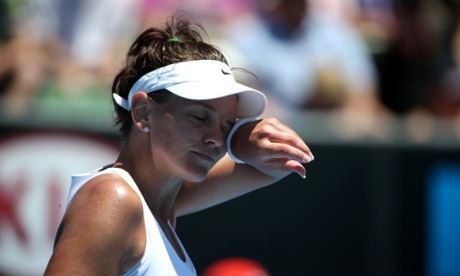
Climate change will threaten the viability of grassroots sport in Australia, and elite tournaments will have to adapt to rising temperatures, extreme rainfall and shrinking snow cover, a report has warned.
The extreme heat policies of sports such as tennis, Aussie rules and cricket will have to “dramatically improve” to protect the health of competitors at all levels, the Climate Institute analysis concluded.
The report, featuring a foreword from former AFL chief executive Andrew Demetriou, warned that while elite sport might be able to adapt to a changing climate, the “ability to respond at local sporting grounds is more questionable”.
The Climate Institute compiled the report in the wake of the blistering heat that affected the Australian Open tennis tournament last year. Players and court staff fainted, water bottles melted and a participant even warned someone might die after temperatures hit 43C.
The Open has since introduced new protocols that require the match referee to consider suspending play if the ambient temperature reaches 40C.
But the Climate Institute warned that the heat policies of other sports were patchy, with a recent AFL match taking place in 38C heat and last year’s Tour Down Under having no heat stipulations, even though cycling races in certain states are normally halted in extremely high temperatures.
“Heat policies are a bit confused and ambiguous between state and national levels,” said John Connor, chief executive of the Climate Institute. “The Australian Open got caught short last year and these tournaments need to have proper heat policies given extreme heat is becoming more common.
“Sport is very dear to people, it’s core to our way of life and it is worth $13bn a year to the Australian economy. Some sports will be at the limit of their ability to adapt or will have massive costs in order to continue, due to climate change.
“Some sports could wither on the vine if we choke off local sports. Professional tennis players can have retractable roofs and be wrapped in cotton wool but we risk the grassroots feed-in of those sports.”
According to climate projections published by the CSIRO and Bureau of Meteorology this week, Australia will warm by up to 5C by the end of the century if greenhouse gas emissions aren’t curbed.
The number of days over 35C is set to treble in Melbourne and Hobart and quadruple in Sydney. In Brisbane, there would be 20 times more hot days, while Perth would spend two months a year above 35C and Darwin 10 months a year above that mark.
The Climate Institute warned this would have a significant impact on the health of sports participants. And elongated droughts in parts of Australia, coupled with extreme rainfall, will degrade community sporting grounds and even affect large stadiums, such as the Suncorp stadium in Brisbane, which was covered in 1.5m of water during the 2011 Queensland floods.
Some of the most dramatic changes could hit those who enjoy winter sports, with the CSIRO report warning of “very substantial decreases in snowfall, increase in melt and thus reduced snow cover”.
The Climate Institute cites further research by Griffith University that predicts a 60% reduction in snow cover by 2020, making it increasingly hard for skiers and snowboarders to enjoy the slopes.
During the 2014 Winter Olympics in Sochi, Russia, more than 100 athletes put their name to a letter from US skier Andy Newell, who warned that climate change must be tackled due the “reality” of deteriorating snow conditions.
The Australian Olympic aerial skier Lydia Lassila said: “Given the unpredictable nature of our Aussie winter, many Australian athletes already train predominantly at overseas facilities or resorts.
“Although I would like to train on home soil, I haven’t been able to since 2009 due to inconsistency of the conditions.”
Connor said: “These impacts increase exponentially the longer we stuff around. Team Australia, if I can borrow that phrase, needs to lift its climate game. If we don’t stop pumping heat-trapping pollutants into the atmosphere, things are going to get worse.”
